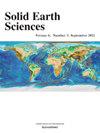利用扎格罗斯褶皱推覆带外法尔斯地区古环境中的等深线图调查油气潜力
IF 2
4区 地球科学
Q3 GEOSCIENCES, MULTIDISCIPLINARY
引用次数: 0
摘要
中东是全球能源生产的重要中心,这主要归功于其巨大的油气储量,尤其是在扎格罗斯褶皱-推力带(ZFTB)内。本研究特别调查了内扎马巴德断层对法尔斯外部地区沉积和油气积累的影响。研究采用了先进的方法--包括等深线图和盆地模型--来考察内扎马巴德断层周围的源岩、储层岩和盖岩的空间分布。值得注意的是,研究结果表明,内扎马巴德断层是一个重要的基底断层,在地质时代积极控制着油气分布。等距图显示地层厚度存在显著差异,这反映了区域应力模式的变化。这种应力差异是形成断裂、褶皱和构造陷阱的根本原因,对碳氢化合物的迁移和积累至关重要。分析表明,邻近 Nezamabad 断层的地区具有成功钻探的潜力,特别是在 Fahliyan 和 Sarvak 地层,这两个地层的厚度模式一致,表明沉积条件稳定。相反,伊拉姆地层和古尔皮地层受构造活动影响,厚度变化明显,表明沉积环境更为复杂。将等深线数据与地质力学建模和地质见解相结合,加深了对 ZFTB 地区应力动态与油气潜力之间复杂关系的理解。这些发现具有重大意义,为完善勘探和生产战略,优化这一能源丰富地区的碳氢化合物开采奠定了基础。此外,还强调了基底断层在油气系统中的关键作用,为今后旨在提高中东地区资源利用率的研究铺平了道路。本文章由计算机程序翻译,如有差异,请以英文原文为准。

Investigating hydrocarbon potential utilizing isopach maps in the paleo-environment of the external Fars region, Zagros fold-thrust belt
The Middle East serves as a vital center for global energy production, largely attributable to its vast hydrocarbon reserves, especially within the Zagros Fold-Thrust Belt (ZFTB). This study specifically investigates the influence of the Nezamabad Fault on sedimentation and hydrocarbon accumulation within the external Fars region. Advanced methodologies— including isopach maps and basin modeling—were employed to examine the spatial distribution of source rocks, reservoir rocks, and cap rocks around the Nezamabad Fault. Notably, the findings reveal that the Nezamabad Fault functions as a significant basement fault, actively controlling hydrocarbon distribution during geological epochs. The isopach maps show significant differences in formation thickness, which reflect variations in regional stress patterns. This differential stress has been fundamental in forming fractures, folds, and structural traps, critical for hydrocarbon migration and accumulation. The analyses indicate that areas adjacent to the Nezamabad Fault demonstrate potential for successful drilling efforts, especially within the Fahliyan and Sarvak Formations, which have shown consistent thickness patterns, suggesting stable sedimentation conditions. Conversely, the Ilam and Gurpi Formations exhibited significant thickness variations influenced by tectonic activity, indicating a more complex sedimentological environment. The integration of isopach data with geomechanical modeling and geological insights has enhanced the understanding of the complex relationships between stress dynamics and hydrocarbon potential in the ZFTB. These findings have significant implications, providing a foundation for refining exploration and production strategies to optimize hydrocarbon extraction in this energy-rich region. Additionally, the critical role of basement faults in hydrocarbon systems has been highlighted, paving the way for future research aimed at improving resource utilization in the Middle East.
求助全文
通过发布文献求助,成功后即可免费获取论文全文。
去求助
来源期刊

Solid Earth Sciences
GEOSCIENCES, MULTIDISCIPLINARY-
CiteScore
3.60
自引率
5.00%
发文量
20
审稿时长
103 days
 求助内容:
求助内容: 应助结果提醒方式:
应助结果提醒方式:


